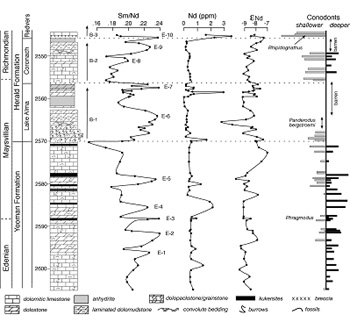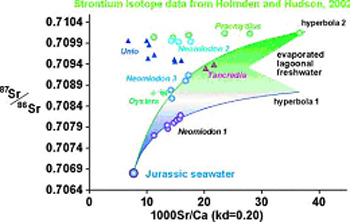Techniques Used
Studies of the ancient earth environment utilise a variety of isotope systems, including Sr, Nd, O and C to better understand the processes which formed geological sedimentary successions.
Example Applications
Nd isotope Stratigraphy |
|
 |
Graduate student Kerrie Fanton has shown that stratigraphic variations of eNd in whole-rock carbonates and conodonts record the submergence history of the North American craton in the late Ordovician. The link with sea level allows the eNd stratigraphy to be used for correlating carbonate successions between intracratonic basins. She has also shown using the Sm/Nd ratio that REE fractionation in carbonates and conodonts is a potential paleodepth proxy in epeiric seas. Work continues to firm up this important result with additional case studies, and applications to epeiric sea circulation. We are also developing a Nd isotope and Sm/Nd stratigraphic framework that will tie together intracratonic basins across the North American continent for high-resolution studies (spatial and temporal) of epeiric sea hydrodynamics. For further information, contact Chris Holmden |
Environment of Formation of the Great Estuarine Group |
|
| The great Estuarine Group is generally renowned as a classic example of salinity controlled ecological diversity amongst a molluscan fauna. However, for the majority of these fossils, which are about 150 million-years old, the isotopes of the element strontium contained within their shells, reveals a very different story. It turns out that the majority of these ancient mollsucs lived in shallow, hydrologically closed, lagoons that periodically dried up completely.The estuarine-like patterns of molluscan diversity were actually the result of differential evaporation of freshwaters in lagoons, rather than seawater mixing with freshwater as in an estuarine environment. Paleontologist and co-author, John Hudson of Leicester University, who has worked on the deposit his entire career, compared the news of these results to a "bomb" dropping on his desk. He and staff of the Saskatchewan Isotope Laboratory continue to explore new ways that isotopes may be used as tracers in paleoecology. For further information, contact Chris Holmden |
 |


